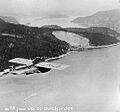Dornier Flugzeugwerke facts for kids
 |
|
| Privately held company | |
| Fate | Acquired by Fairchild Aircraft in 1996 |
| Successor | Airbus |
| Founded | 1914 |
| Defunct | 2002 |
| Headquarters | Manzell, Friedrichshafen, Germany |
|
Key people
|
Claude Dornier |
| Parent | Daimler-Benz (from 1985) |
Dornier Flugzeugwerke was a German company that built many different types of airplanes. It was started in 1914 by Claude Dornier in Friedrichshafen, Germany. Over its long history, the company created many aircraft for both everyday travel and military use.
Contents
The Story of Dornier Aircraft
Early Days and Famous Flying Boats
Dornier started as Dornier Metallbau. In 1923, it took over the factories of another company, Flugzeugbau Friedrichshafen. These factories were in places like Weingarten and Warnemünde.
Between World War I and World War II, Dornier became famous for its large, all-metal flying boats. These were airplanes that could land and take off from water. One famous flying boat was the 1924 Wal (meaning "Whale"). It was used for many long-distance flights. The huge Do X also set records for its size and weight.
Dornier also made successful land-based airliners. These included the Komet (Comet) and Merkur (Mercury). Airlines like Lufthansa used them in the 1920s and early 1930s.
For a while, Dornier built its planes outside Germany. This was because of rules from the Treaty of Versailles after World War I. These rules limited what Germany could build. So, Dornier built planes in places like Altenrhein, Switzerland. Other companies in Italy, Spain, Japan, and the Netherlands also built Dornier planes under a special agreement. When the Nazi government came to power, these rules were ignored. Dornier then started building planes in Germany again.
World War II and Military Planes
The success of the Wal flying boats led to new designs. These included the Do 18 and Do 24. These planes were used by several armed forces, including Germany's, during World War II.
Dornier's most important military plane in World War II was the Do 17. People nicknamed it The Flying Pencil because of its narrow shape. It first flew in 1934 as a mailplane for Lufthansa. But it wasn't good for carrying mail. So, Dornier turned it into a military aircraft. A prototype bomber flew in 1935. In 1937, it was used by Germany in the Spanish Civil War.
The Do 17 became a medium bomber for the Luftwaffe (German air force). It was used early in World War II, especially during the Battle of Britain. Later, it was changed into a nightfighter to fight against RAF bombers. Dornier also developed the Do 217, which looked similar but was a new, larger design. Dornier also made the Do 335. This was the fastest piston-engined fighter of the war. But it was built too late to be used in battle.
After the War: New Beginnings
After World War II, Germany was again not allowed to build aircraft. So, Dornier moved to Spain and then to Switzerland. There, the company offered advice on airplanes. In 1954, Dornier returned to Germany.
After the war, Dornier became successful again. They made STOL (Short Take-Off and Landing) planes like the Do 27 and Do 28. These were utility planes, meaning they could be used for many different jobs. In 1974, Dornier worked with French companies to create the Alpha Jet.
In 1983, a company in India, Hindustan Aeronautics Limited (HAL), got permission to build the Dornier 228. They made these planes for the Asian market. By 2013, HAL had built 117 Dornier 228 aircraft.
In 1985, Dornier became part of the Daimler-Benz group. This meant Dornier's aircraft parts joined the larger company. A part of Dornier that made textile machines became a separate family-owned company called Lindauer Dornier GmbH. The rest of Dornier was split into different parts for defense, satellites, medical technology, and aircraft.
In 1996, most of Dornier Aircraft was bought by Fairchild Aircraft. They formed a new company called Fairchild Dornier. This company ran into financial trouble in 2002 and closed down. An American company bought the rights to build its 328 Jet. Other parts of Dornier became part of EADS, a big aerospace company. The Dornier 228 production was taken over by a Swiss company, RUAG, and later by General Atomics.
Other Dornier Companies
The part of Dornier that made medical equipment was sold. It is now called Dornier MedTech. This company makes medical devices. For example, they make machines to treat kidney stones. They also make laser devices for many uses.
The Dornier family also started other companies.
Dornier Seaplane Company
The Dornier family has a company called Dornier Seawings. They developed the Dornier Seastar. This is a special turboprop-powered amphibious aircraft. It is made mostly of new, lightweight materials. It can land on both water and land.
Dornier Technologie
Claude Dornier's grandson, Iren Dornier, started Dornier Technologie in 1996. This company makes the Dornier S-Ray 007 aircraft.
Dornier Aircraft Models
Here are some of the aircraft Dornier developed after 1945:
- Dornier Do 25 - A prototype for the Do 27
- Dornier Do 27
- Dornier Do 28 - Developed from the Do 27
- Dornier Do 29
- Dornier Do 31
- Dornier Do 32
- Dornier 128
- Dornier Do 132
- Dornier 228 - Developed from the Do 28
- Dornier Do 231
- Dassault/Dornier Alpha Jet
- Dornier 328
- Fairchild Dornier 328JET
- Fairchild Dornier 428JET
- Fairchild Dornier 728 family
- Dornier Aerodyne
- Dornier Seawings Seastar
- Dornier S-Ray 007
- Dornier LA-2000 (A study for a stealth attack aircraft)
Dornier Car Projects
Dornier also worked on some car designs:
- Dornier Delta
- Dornier Delta II, made for the company Hymer
Dornier Faint Object Camera for Hubble
Dornier GmbH built the Faint Object Camera (FOC) for the Hubble Space Telescope. This camera was used from 1990 to 2002. The ESA paid for this camera. It had two complete camera systems. They were designed to take very clear pictures, even of very faint light. It could see UV light from 115 to 650 nanometers. The FOC was the last original instrument on the Hubble. It was replaced in 2002 by a newer camera.
Missile Projects
- Dornier Viper
Spacecraft
- AMC-5 (a satellite)
- Project 621 (rocket)
Images for kids
-
The Dornier Wal flown by Roald Amundsen on his first try to reach the North Pole.
-
The Dornier Do 17 "flying pencil" bomber.
-
NASA astronauts removing the Faint Object Camera (FOC) from the Hubble Space Telescope during a spacewalk.
See also
- Dornier Museum Friedrichshafen
- List of RLM aircraft designations
- Zündapp Janus








